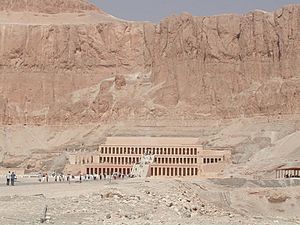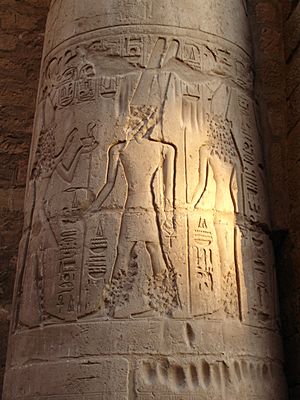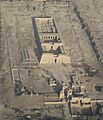Egyptian temple facts for kids
Egyptian temples were buildings for the official worship of the gods in ancient Egypt. These temples were seen as houses for the gods. Sometimes they were specially for the pharaohs (kings). Within these temples the Egyptians performed a variety of rituals of the Egyptian religion. People would give offerings (gifts) to the gods. They would show the stories of the gods through festivals. These festivals would also help normal life to continue. The pharaohs were responsible for providing the temples and caring for the gods. This required a lot of labor and material for building and maintenance. It was necessary for the pharaohs to give this responsibility to priests. Most of the ordinary people did not take part in ceremonies and could not enter special parts of the temple. The temple was an important religious place for all classes of Egyptians. They went there to pray, give offerings, and seek guidance from the god dwelling within.
The most important part of the temple was the sanctuary. The sanctuary was the most secret and special place and usually had a statue of a god. In the early years of Egypt, about 3000 BCE, the temples were small. Priests and pharaohs added more rooms and the temples became bigger. The rooms would have a lot of decoration of the religion. By the time of the New Kingdom (c.1550-1070 BCE) the temples were huge buildings made of stone. The buildings were arranged in special ways for the religion. The temple would have halls, open areas, and very large entrance pillars. Some of these temples still exist today. Beyond the main temple was an outer wall. There would be other buildings inside the walls.
A large temple also had a lot of land and employed thousands of ordinary people to supply its needs. Temples were also economic centers. The priests who managed the temples had a lot of influence. They would sometimes oppose the king.
Temple-building continued in Egypt even when the nation declined and was ruled by the Roman Empire. Christianity brought more pressure on Egyptian religion. The last temple was closed in 550 CE. For hundreds of years, the ancient buildings were damaged and neglected. In the early 19th century, many people in Europe became interested in ancient Egypt. The study of ancient Egypt became known as the science of Egyptology. Egyptologists continue to study the surviving temples and the remains of destroyed ones. They tell us a lot about ancient Egyptian society.
Dozens of temples survive today. Some have become famous tourist attractions that bring money to modern Egypt.
Images for kids
-
The Temple of Isis at Philae, with pylons and an enclosed court on the left and the inner building at right. Fourth to first century BC.
-
Low relief of Seti I performing rituals for the god Amun, from Seti's mortuary temple at Abydos. Thirteenth century BC
-
Sunk relief of personified provinces of Egypt bearing offerings for the temple god, from the mortuary temple of Ramesses II at Abydos. Thirteenth century BC
-
Reconstruction of the Old Kingdom pyramid temple of Djedkare Isesi, with causeway leading out to the valley temple. Twenty-fourth century BC.
-
Entrance pylon of Luxor Temple, one of the major New Kingdom temples. Fourteenth to thirteenth century BC.
-
Roman-era mammisi at Dendera Temple complex. First to second century AD.
-
Stone construction in a wall of the Valley Temple of Khafre. Twenty-sixth century BC.
-
A rock-cut chamber in the Great Temple of Abu Simbel. Thirteenth century BC.
-
The temple of Ramesses III at Medinet Habu, surrounded by the remains of subsidiary structures. Twelfth century BC.
-
Shrine in the cella of the Temple of Edfu. Fourth to third century BC
-
Amenhotep III presents a variety of offerings in a relief from Luxor Temple. Fourteenth century BC.
-
Votive statue of a man donating a shrine containing a figure of Osiris. Thirteenth to eleventh century BC.
-
Reconstruction work on the Ninth Pylon at Karnak (fourteenth century BC), from whose interior talatat blocks from the Amarna Period are being retrieved
-
Frieze of sculpted uraei, or rearing cobras, atop a wall at the pyramid complex of Djoser. Twenty-eighth century BC.
-
Obelisk of Senusret I at Heliopolis. Twentieth century BC.
See also
 In Spanish: Templo egipcio para niños
In Spanish: Templo egipcio para niños



























